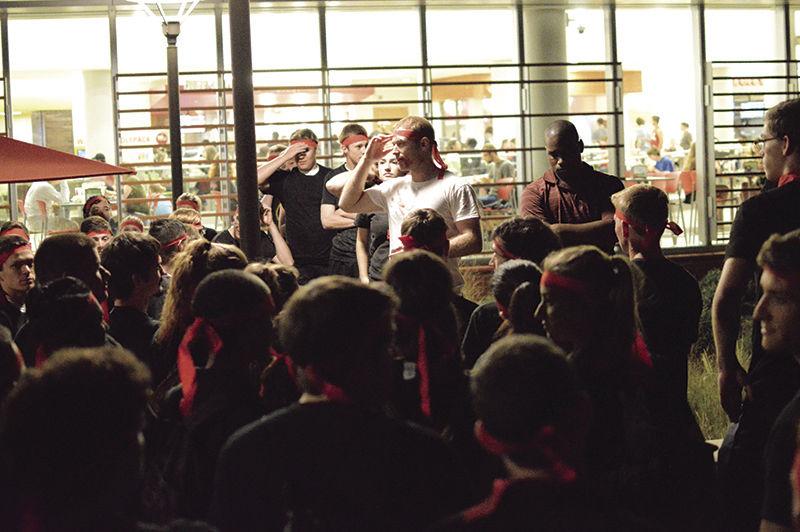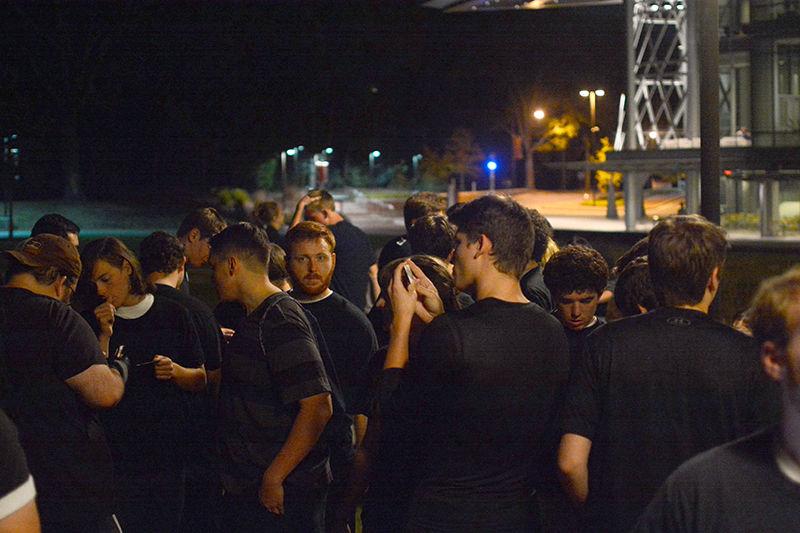Saturday night saw many people darting around cars, scaling walls and screaming bloody murder while in a frantic chase. NC State’s campus — for only one night — was invaded by an increasingly large zombie horde of the undead. It’s not science fiction or horror, it’s Survive Raleigh VII.
Survive Raleigh is an elaborate game of tag with a horror twist that is played twice a year at NC State in October and March or April. The event is put on by Wake Tech student Deshawn Utley and has been a tradition at NC State since 2010.
“I took the mantle of event organizer in spring of 2014, and have been event organizer ever since,” Utley said. “I decided to take the event because I knew the inner workings of the game, and I had new ideas that could be implemented. I also did not want the game to end up becoming defunct.”
The event is free and the only items participants need to play are a white and black T-shirt. The game is essentially hide-and-go-seek. Everyone starts as a human in a black T-shirt. They remain human until they are tagged by a player in a white shirt, representing a zombie. Zombies try and “kill” all of the human characters while humans try and reach various checkpoints in or around campus.
Saturday’s event had five different checkpoints: Jordan Hall, behind Carmichael Gym, a gazebo in Pullen Park, the middle of Harris Field and the Belltower. Before the event started at 7:30 p.m., players were given a small map marking these locations. Also prior to start, the initial zombies, NC State’s parkour team, are released into campus ahead of the survivors.
Stretching, pacing, planning or panicking, teams of players prepared to run for their lives in front of Talley Student Union. At the call of “go” players fanned out in all directions. Some sprinted for Cates Avenue. Others ran down Dunn Avenue. Most flooded across Wolf Plaza, ducking around confused students, shrubs and wolf statues. After the first cry of “zombie,” the crowd broke into a frenzied sprint as players ran to reach the safety of the nearest checkpoint or just to be faster than the slowest person.
If this first 10 minutes of panic are survived, a player and his or her team have roughly two hours to reach each checkpoint, collect a card as proof of their journey and reach Talley Student Union at a certain time. During those few hours, NC State’s campus is transformed from everyday life into choke points, dead ends, hiding spots and vantage points. The experience, while somewhat silly, can still feel intense, especially further into the game when the ratio of humans to zombies begins to shift.
If tagged, a human player must give up their survivor card and map to the zombie that catches them. Some students found interesting ways to use this to their team’s advantage.
“My party of five all jumped a fence by Pullen,” said Quintin Peiffer, a freshman studying engineering. “We saw a zombie right around the corner, and I realized it would be better for me to stall him like we had previously discussed. I took my time pulling my kill card out of my wallet. I even started asking him questions like ‘Where’s the nearest person?’ I made him stand there for two and a half minutes while my team got away.”
This writer found his end after jumping over a hedge and park bench in front of the Student Health Center, near the Harris Field checkpoint. The jump was successful. The landing was not. Once caught, a new game opened up and zombie life began.
Surprising teams on the dark trails near Pullen Park, chasing lone survivors through North Campus and searching every conceivable hiding spot made being a zombie fun in a different way. The card system, new to this year’s Survive Raleigh, added a competitive element on the zombie side to see who could tag the most people and collect the most cards.
Of the nearly 200 players who participated, only 13 players managed to reach Talley alive, two of who managed to find a secret bonus checkpoint. One survivor who made it to the end was Andrew Hamrick, a sophomore studying paper science engineering.
“When I’m trying to hide, I don’t do well in groups,” Hamrick said. “Being in a group draws attention. I can’t prevent that. I left two separate groups that I was running with in order to find my own way to get to checkpoints, which in the end turned out to be successful since most of my team members died.”
Utley says he plans for the next Survive Raleigh to happen sometime in March next year.
“The NCSU student body look forward to this game two times a year, and I love watching them have the time of their lives during the game,” Utley said. “This what keeps me running the event, and listening to their fun and creative ideas every year.”
Students gather outside of Talley Student Union on Saturday to receive their maps in preparation for the Survive Raleigh event. The map showed the five checkpoints — the pond in Pullen Park, Witherspoon Student Center, the Belltower roundabout, Weisiger-Brown Athletic Facility and Jordan Hall — participants had to find and was drawn in a non-descript manner to make surviving more difficult.









